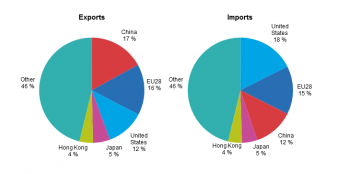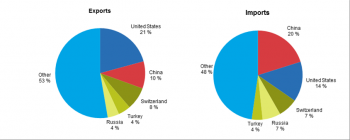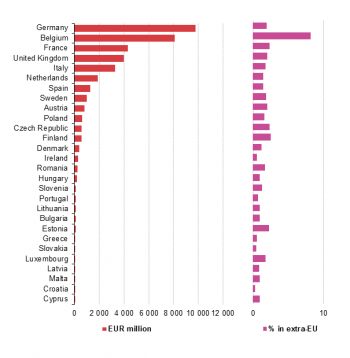Archive:India-EU – international trade in goods statistics
- Data extracted in September 2017. Most recent data: Further Eurostat information, Main tables and Database. Planned article update: October 2018.
This article provides a picture of the trade in goods between the European Union (EU) and India. It analyses the type of goods exchanged between the two economies and the shares of each EU Member State in those exchanges.
Source: Eurostat (ext_lt_introle)

Source: Eurostat (ext_lt_maineu)
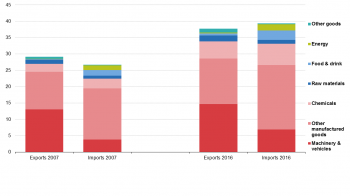
Source: Eurostat (DS-018995)
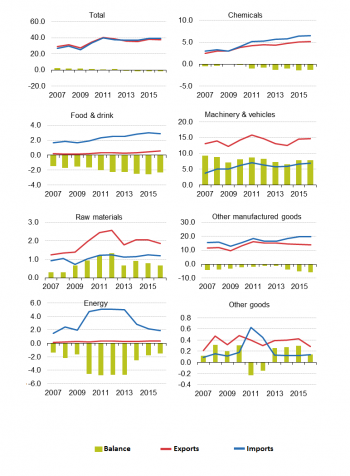
Source: Eurostat (DS-018995)

Source: Eurostat (ext_st_eu28sitc)
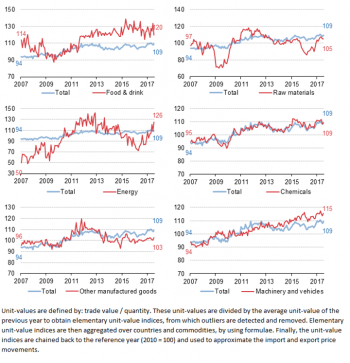
Source: Eurostat (ext_st_eu28sitc)

Source: Eurostat (DS-018995)
Main statistical findings
- In 2016, India was the thirteenth largest exporter of goods in the world with a share of 2 % of world exports and the 9th largest importer with a share of 2.8 % of world imports.
- India was the 10th largest importer of goods from the EU and the 9th largest exporter of goods to the EU in 2016.
- In 2007, the EU recorded the highest trade surplus with India recorded over the last 10 years. Since then it dropped from of EUR 4.6 billion and first became a trade deficit in 2013 which in 2016 had grown to EUR 3.9 billion.
- Manufactured goods dominate both the exports of goods from the EU to India and imports from India to the EU accounting for over 90 % of the total exports and 84 % of total imports.
- Among EU Member States, the United Kingdom is the largest importer (EUR 7.3 billion) from and 4th largest exporter (EUR 4.0 billion) to India and has the largest trade deficit with India (EUR 3.3 billion).
- Among EU Member States, Germany is the largest exporter (EUR 9.7 billion) to and 2nd largest importer (EUR 6.3 billion) from India and has the 2nd largest trade surplus with India (EUR 3.4 billion) after Belgium (EUR 3.7 billion, imports: EUR 4.4 billion, exports: EUR 8.1 billion)
EU and India in world trade in goods
Figure 1 shows that four largest exporters account for almost half of the world exports. The largest is China (17 %) followed by the EU (15 %), the USA (12 %) and Japan (5 %). The same four also account for almost half of the world imports but in different order. Here the USA (18 %) leads, followed by the EU (15 %), China (12 %) and Japan (5 %). India is the 13th largest exporter, accounting for 2.1 % of world exports and the 9th largest importer accounting for 2.8 % for world imports.
Figure 2 focusses on the evolution of trade of the EU and of India over the period 2007-2016. India's exports grew more rapidly than those of the EU especially between 2009 and 2013 when they peaked at 238 % of their 2007 level. Between 2013 and 2014 EU exports remained at the same level while Indian exports dropped somewhat. Growth of India's imports is very close to growth of exports although in 2016 imports dropped somewhat. The cover ratio (exports divided by imports ) for India was 73 % in 2016, indicating a substantial trade in goods deficit. Since 2009 the EU's imports have been growing less quickly than exports, which resulted in a cover ratio of more than 100 % (in other words a trade surplus) since 2013.
India has a small trade surplus with the EU
Figure 3 shows that in 2016, India had a share of 2 % in both extra-EU exports (EUR 38 billion) and extra-EU imports (EUR 39 billion). This meant it was the 10th largest importer ahead of Vietnam (EUR 33 billion) and just behind South Korea (EUR 42 billion). India was the 9th largest exporter ahead of Canada (EUR 35 billion) and again behind South Korea (EUR 44 billion) .
India has been recording a trade deficit with the EU from 2007 to 2012 (see Figure 4). In this time span, trade between the two economies had a low in 2009, but quickly regained momentum, peaking in 2011 after which they declined until 2014 but then started recovering. The patterns for imports and exports are roughly the same. Since 2013 India has a small trade surplus with the EU amounting to EUR 1.6 billion in 2016.
EU trade with India largely dominated by manufactured goods
When breaking down imports and exports by SITC [Glossary] groups, the main categories driving the exports to and imports from India are ‘Machinery and vehicles’ (SITC 7), ‘Chemicals’ (SITC 5) and ‘Other manufactured goods’ (SITC 6&8). Together they accounted for around 90 % of the EU exports and 84 % of imports (see Figure 5). In 2017, in exports from the EU to India, ‘Machinery and vehicles’ (39 %) and ‘Other manufactured goods’ (37 %) had almost equal shares. In contrast in import from India ‘Other manufactured goods’ (50 %) is almost three times as large as ‘Machinery and vehicles’ (17 %)
Figure 6 shows the evolution of the EU imports and exports by product category since 2007. The EU has trade deficits in '"Other manufactured goods', 'Chemicals', 'Food & drink' and Energy" and surplusses in ‘Machinery and vehicles’, 'Raw materials' and, most of the years, in "Other goods".
Figure 7a shows the unit value index or different product groups imported from India. For most of the product groups the line are fairly similar to the unit value index for the total. Only for 'energy' there are large fluctuations, possibly due to price fluctuations on world markets. In 'machinery and vehicles' the unit value index started moving away from the total since 2013 and in 2016 had a value of 137 % compared to 116 % for the total
In the unit value index for exports it is also 'energy' where the largest fluctuation are starting at only 50 % in 2007 and climbing above 140 % in 2012 after which they dropped to the same level as the unit value index for the total in 2016 at 108 %. In 2016 in 'machinery and vehicles' (134 %) the unit value index was also noticeably higher than the one for total exports. (see figure 7b).
Most traded goods: pearls and (semi-) precious stones
Figure 8 gives more details about the goods exchanged between the EU and India, showing the top 20 traded goods in a detailed way (by SITC level 3). Those top 20 goods covered around 45 % of total traded goods in 2016. Eight products among the top-20 belong to the ‘Machinery and transport equipment’ group and four "Miscellaneous manufactured products". 'Pearls and (semi-) precious stones' were the most traded product followed by 'organo-inorganic and related compounds' and 'petroleum oils other than crude'.
Another interesting way to look at data is to investigate the export/import ratio of traded goods, in order to better identify the direction taken by flows and specialisation between the two areas. These ratios can be found in the right margin of Figure 9. For the top product, pearls and (semi-) precious stones', the ratio = 3.1 meaning that the EU exports three times as much as they import. For the next two products the ratios are 0.2 and 0.1 respectively indicating that here the EU has a trade deficit with Inida. Amont the top 20 products high values are found for 'measuring instruments (SITC 874) , aircraft (SITC 792) and 'other machinery (SITC 728)'. Very low values are found for some textile products (SITC 845 and 658), footwear (SITC 851) and seafood (SITC 036).
Germany is the Member States trading most with India
Figure 9a shows Member States' imports from India and the share of the partner India in national extra-EU imports. Table 9b provides similar information but considering Member States' exports to India.
There are seven countries whose import from India in 2016 were higher than EUR 3 billion. These were the United Kingdom, Germany, Belgium, Italy, the Netherlands , France and Spain. Together they accounted for almost 84 % of imports from India.
The same seven countries were also the largest exporters to India but in a different order. Their combined share in exports to India was a little over 82 %.
Figure 9c shows that 11 countries have a trade surplus with India ranging from just EUR 2 million for Romania to EUR 3 391 billion for United Kingdom. The remaining 17 countries have a trade deficit, starting at EUR - 13 million for Latvia to EUR 3 758 million for Belgium, just ahead of Germany (EUR 3 504 billion).
Data sources and availability
EU data is taken from Eurostat's COMEXT database. COMEXT is the reference database for international trade in goods. It provides access not only to both recent and historical data from the EU Member States but also to statistics of a significant number of third countries. International trade aggregated and detailed statistics disseminated via the Eurostat website are compiled from COMEXT data according to a monthly process.
Data are collected by the competent national authorities of the Member States and compiled according to a harmonised methodology established by EU regulations before transmission to Eurostat. For extra-EU trade, the statistical information is mainly provided by the traders on the basis of customs declarations.
EU data are compiled according to Community guidelines and may, therefore, differ from national data published by the Member States. Statistics on extra-EU trade are calculated as the sum of trade of each of the 28 EU Member States with countries outside the EU. In other words, the EU is considered as a single trading entity and trade flows are measured into and out of the area, but not within it.
Data for the other major traders are taken from the Comtrade database of the United Nations. Data availability differs among countries, therefore Figure 1 shows the latest common available year for all the main traders. For the calculation of shares the world trade is defined as the sum of EU trade with non-EU countries (source: Eurostat) plus the international trade of non-EU countries (source: IMF Dots database).
Methodology
According to the EU concept and definitions, extra-EU trade statistics (trade between EU Member States and non-EU countries) do not record exchanges involving goods in transit, placed in a customs warehouse or given temporary admission (for trade fairs, temporary exhibitions, tests, etc.). This is known as ‘special trade’. The partner is the country of final destination of the goods for exports and the country of origin for imports.
Product classification
Information on commodities exported and imported is presented according to the Standard international trade classification (SITC). A full description is available from Eurostat’s classification server RAMON.
Unit of measure
Trade values are expressed in millions or billions (109) of euros. They correspond to the statistical value, i.e. to the amount which would be invoiced in case of sale or purchase at the national border of the reporting country. It is called a FOB value (free on board) for exports and a CIF value (cost, insurance, freight) for imports.
Context
Trade is an important indicator of Europe’s prosperity and place in the world. The block is deeply integrated into global markets both for the products it sources and the exports it sells. The EU trade policy is an important element of the external dimension of the ‘Europe 2020 strategy for smart, sustainable and inclusive growth’ and is one of the main pillars of the EU’s relations with the rest of the world.
Because the 28 EU Member States share a single market and a single external border, they also have a single trade policy. EU Member States speak and negotiate collectively, both in the World Trade Organization, where the rules of international trade are agreed and enforced, and with individual trading partners. This common policy enables them to speak with one voice in trade negotiations, maximising their impact in such negotiations. This is even more important in a globalised world in which economies tend to cluster together in regional groups.
The openness of the EU’s trade regime has meant that the EU is the biggest player on the global trading scene and remains a good region to do business with. Thanks to the ease of modern transport and communications, it is now easier to produce, buy and sell goods around the world which gives European companies of every size the potential to trade outside Europe.
See also
Further Eurostat information
Data visualisation
Main tables
- International trade in goods (t_ext_go), see:
- International trade in goods - long-term indicators (t_ext_go_lti)
- International trade in goods - short-term indicators (t_ext_go_sti)
Database
- International trade in goods (ext_go), see:
- International trade in goods - aggregated data (ext_go_agg)
- International trade in goods - long-term indicators (ext_go_lti)
- International trade in goods - short-term indicators (ext_go_sti)
- International trade in goods - detailed data (detail)
- EU trade since 1988 by SITC (DS-018995)
Dedicated section
Methodology / Metadata
- International trade in goods statistics - background
- International trade in goods (ESMS metadata file — ext_go_esms)
- User guide on European statistics on international trade in goods
Source data for tables, figures and maps (MS Excel)
External links
- European Commission
Notes
[[Category:<Subtheme category name(s)>|Name of the statistical article]] [[Category:<Statistical article>|Name of the statistical article]]
Delete [[Category:Model|]] below (and this line as well) before saving!
